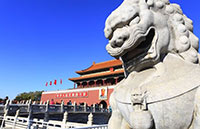Successful regional ethnic autonomy in Tibet
Updated: 2015-09-07 08:17
(China Daily)
|
||||||||
Preface
Regional ethnic autonomy is a fundamental political system under socialism with Chinese characteristics - a basic policy through which to solve problems relating to ethnic minorities.
Regional ethnic autonomy in China means, under the unified leadership of the central government, that regional autonomy is exercised and organs of self-government are established for the exercise of the right of autonomy in areas where various ethnic minorities live in compact communities. The establishment of ethnic autonomous areas is determined by local ethnic relations, economic development and other conditions, with reference to historical background. China's ethnic autonomous areas are divided, according to the population and size of the compact communities in which ethnic minorities live, into autonomous regions, autonomous prefectures, and autonomous counties at three levels, which are equivalent to provinces, cities divided into districts, and counties in the administrative division.
Tibet is an ethnic region mostly inhabited by Tibetans, who account for more than 92 percent of its present 3,175,500 population, which also includes 40 other ethnic groups, including the Han, Mongolian, Hui, Naxi, Nu, Drung, Monba, Lhoba, Deng and Sherpa people. According to the Constitution of the People's Republic of China (PRC), regional ethnic autonomy has been exercised in Tibet, and Tibet Autonomous Region, under which are the Monba, Lhoba and Naxi ethnic townships, has been founded, protecting by law the political rights of various ethnic groups in Tibet to participate as equals in administering state and local affairs.
Since the democratic reform was carried out in 1959 and regional ethnic autonomy came into practice in 1965, Tibet has established the new socialist system and achieved historic leaps and bounds in its economic and social development. Tibet has taken a road that unites it with all China's ethnic groups and struggles to develop equally, achieve prosperity, and make progress with them. As part of the Chinese nation, the Tibetan people fulfill the right to participate equally in the management of state affairs; they are thus managers of local social affairs and masters of their own destiny, creating and sharing the material and spiritual wealth of Tibet.
Although it has been only 50 years since the founding of Tibet Autonomous Region, great changes have taken place. Tibet is now in its golden age.
- Global health entering new era: WHO chief
- Brazil's planning minister steps aside after recordings revelation
- Vietnam, US adopt joint statement on advancing comprehensive partnership
- European border closures 'inhumane': UN refugee agency
- Japan's foreign minister calls A-bombings extremely regrettable
- Fukushima impact unprecedented for oceans: US expert

 Stars of Lijiang River: Elderly brothers with white beards
Stars of Lijiang River: Elderly brothers with white beards
 Wealthy Chinese children paying money to learn British manners
Wealthy Chinese children paying money to learn British manners
 Military-style wedding: Fighter jets, grooms in dashing uniforms
Military-style wedding: Fighter jets, grooms in dashing uniforms
 Striking photos around the world: May 16 - May 22
Striking photos around the world: May 16 - May 22
 Robots help elderly in nursing home in east China
Robots help elderly in nursing home in east China
 Hanging in the air: Chongqing holds rescue drill
Hanging in the air: Chongqing holds rescue drill
 2.1-ton tofu finishes in two hours in central China
2.1-ton tofu finishes in two hours in central China
 Six things you may not know about Grain Buds
Six things you may not know about Grain Buds
Most Viewed
Editor's Picks

|

|

|

|

|

|
Today's Top News
Liang avoids jail in shooting death
China's finance minister addresses ratings downgrade
Duke alumni visit Chinese Embassy
Marriott unlikely to top Anbang offer for Starwood: Observers
Chinese biopharma debuts on Nasdaq
What ends Jeb Bush's White House hopes
Investigation for Nicolas's campaign
Will US-ASEAN meeting be good for region?
US Weekly

|

|









